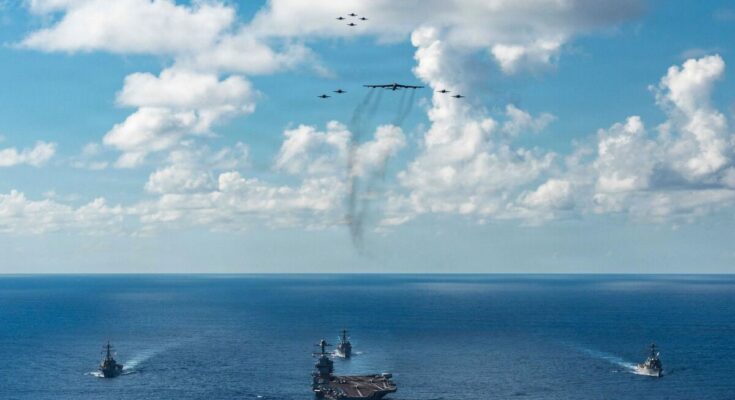The United States on Sunday announced the arrival of the aircraft carrier “USS Gerald Ford” in the Caribbean Sea, officially as part of an operation to combat drug trafficking, but this came amid rising tensions with Venezuela.
A press release from America’s command for Latin America and the Caribbean, Southcom, clarified the location of the carrier group, following Tuesday’s announcement that it had entered its area of responsibility the same day.
The USS Gerald Ford, the most advanced aircraft carrier in the US Navy, carries four squadrons of fighters and is accompanied by three guided missile destroyers.
The carrier strike group “will join those already in the Caribbean Sea,” including the amphibious group and Marine units on board, a Southcom press release detailed.
Since August, Washington has maintained a significant military presence in the Caribbean, including half a dozen warships, to officially combat drug trafficking to America.
In recent weeks, the United States has carried out around twenty airstrikes in the Caribbean and Pacific against ships accused – without providing evidence – of transporting drugs, causing a total of 76 casualties. Venezuela accused Washington of using drug trafficking as a pretext “to force regime change” in Caracas and confiscate its oil.
Donald Trump, who authorized covert CIA operations in Venezuela, has given contradictory indications of his strategy, at times mentioning attacks on Venezuelan soil and counting the days of President Nicolás Maduro, but also ruling out the idea of war. Alongside Washington’s statement on Tuesday, the Venezuelan army announced a “massive” deployment across the country, fighting American “imperialism.”
The US government “made” the war for Maduro
The United States has long used aircraft carriers to suppress and deter other countries’ aggression because its warplanes can strike targets deep inside other countries. However, some experts claim that the “USS Gerald Ford” is not suitable for fighting cartels, but the ship could be an effective instrument of intimidation to encourage President Maduro to resign.
In this context, Secretary of State Marco Rubio reiterated that the United States does not recognize the Maduro regime, which many accused of stealing last year’s election, as the legitimate leader of Venezuela. Rubio called the Venezuelan government a “transshipment organization” that openly collaborates with drug traffickers.
Maduro, who faces narcoterrorism charges in the US, says the US government is “making” war against him. The Venezuelan government recently announced a “massive” mobilization of troops and civilians to defend itself against a possible American attack.
Trump justified the attack on the drug boat by claiming that the United States was in an “armed conflict” with drug cartels and that the boat was operated by a foreign terrorist organization.
“This is a symbol of the return of American military power in Latin America”
He came under fire from regional leaders, the UN High Commissioner for Human Rights and US lawmakers, including Republicans, who demanded more information on the targets and legal justification for the attack on the ship.
However, Senate Republicans recently voted against legislation that would limit Trump’s ability to launch attacks on Venezuela without Congress’ authorization.
Experts disagree over whether US warplanes can be used to attack ground targets in Venezuela.
After all, this 100,000 ton warship was sending a message. “This is a symbol of the return of American military power in Latin America,” said Elizabeth Dickinson, the International Crisis Group’s senior analyst for the Andean region. “This has caused a lot of concern in Venezuela, and also throughout the region. I think everyone is watching this situation with concern, to see to what extent the United States is prepared to use military force.”


